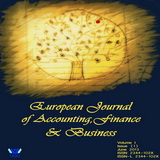|

ISSN: 2344 - 102X
ISSN-L: 2344 - 102X
Our journal is currently indexed in the following databases:
|
| |
Article from Volume 1, Number 1, Year 2013| THE DENATIONALIZATION OF THE BANKS - BASIC OBJECTIVE OF THE RESTRUCTURING OF THE BANKING SYSTEM IN THE CENTRAL AND SOUTH EASTERN EUROPE (CSE) COUNTRIES | 
Download | | Author(s): Anisoara Niculina Apetri, Anamaria Hlaciuc | | DOI: 10.4316/EJAFB.2013.118 | | Abstract: In this study we shall try to elaborate a comparative analysis regarding the policies of the process
of banking denationalization used in five Central and South Eastern Europe (CSEE) countries
(Poland, Slovakia, Hungary, Romania and Bulgaria) during the transition period, as they had a
great influence on the increasing domination of the foreign capital banks and we shall offer a
complete image of the denationalization process that tended in the last years to sell all these banks
to foreign investors. We also intend to make a comparison between the features and the structure
of the banking system in the above mentioned CSEE countries and we will show that in the last
years, each of the five counties noticed an increasing domination of the foreign capital banks,
numerically but also from the point of view of the market share. | | Keywords: Banking System, Foreign Banks, Methods Of The Denationalization, Banking Reform | References:
1. Takata, K. (2005), Evolution Of Banking Sector Structures Within Central-European Countries During Transition, Discussion Paper No. 65, Interfaces For Advanced Economic Analysis, Kyoto University, Pp. 13-14.
2. Barisitz S. (2008), Banking In Central And Eastern Europe 1980-2006, Routledge International Studies In Money And Banking, SUA Canada, Pp. 21.
3. Bonin J., Hasan I., Wachtel P. (2008), Banking In Transition Countries - Oxford Handbook Of Banking Forthcoming June, Pp. 7-9.
4. Bonin J., Hasan I., Wachtel P. (2008), Banking In Transition Countries - Oxford Handbook Of Banking Forthcoming June 2008, Pp. 15-17.
5. Bonin J., Hasan I., Wachtel P. (2008), Banking In Transition Countries - Oxford Handbook Of Banking Forthcoming June 2008, Pp. 11-12
6. Mamatzakis E., Koutsomanoli-Filippaki A., Staikuras C. (2010), On The Determinants Of Banking Efficiency In Four New European Union Member States: The Impact Of Structural Reforms, MPRA Paper No. 24634, Online At Http://mpra.ub.uni-muenchen.de/24634/.
7. Havrylchyk O., Jurzyk E. (2010), Inherited Or Earned? Performance Of Foreign Banks In Central And Eastern Europe, International Monetary Fund WP/10/4 IMF Working Paper, Pp. 3.
8. Claessens S., Demirguc-Kunt A., Huizinga H. (1998), How Does Foreign Entry Affect The Domestic Banking Sector?, World Bank Working Paper No: 1918 (June).
9. Hellmann T., Kevin M., Stiglitz J. (2000), Liberalization, Moral Hazard In Banking And Prudential Regulation: Are Capital Requirements Enough?, American Economic.
10. Demirguc-Kunt A., Huizinga H., Determinants Of Commercial Bank Interest Margins And Profitability: Some International Evidence, World Bank Economic Review, 1999, Vol. 13, No. 2.
11. Agenor P. (2001), Benefits And Costs Of International Financial Integration: Theory And Facts, World Bank Policy Research Working Paper No. 2699.
12. Havrylchyk O., Jurzyk E. (2006), Profitability Of Foreign Banks In Central And Eastern Europe - Does The Entry Mode Matter? Bank Of Finland, BOFIT - Institute For Economies In Transition Bank Of Finland BOFIT Discussion Papers 5, Pp. 7-8.
13. Havrylchyk O. (2010), Foreign Bank Presence And Its Effect On Firm Entry And Exit In Transition Economies, Financial Support Of The European Commission (7th Framework Programme, Grant Agreement No.217266. 14. Report Of Transition BERD (2009), Www.ebrd.com.
15. Raiffeisen Research (2010), Www.rbinternational.com. |
| | Back to journal ... |
|
|
| |
|
|
|

